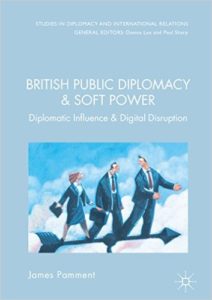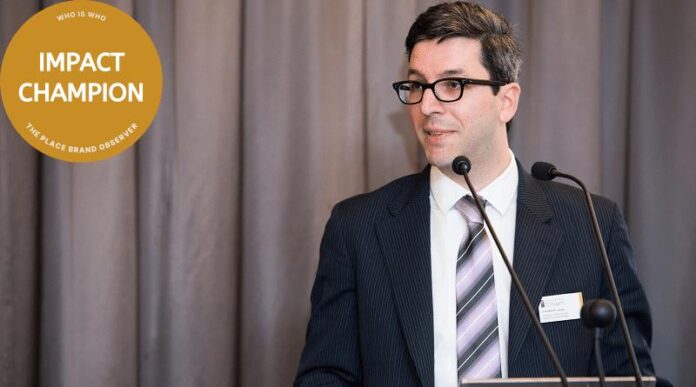Meet James Pamment, a Senior Lecturer in Strategic Communication at Lund University, Sweden. His work addresses issues related to strategic communication, diplomacy, and international development.
Learn about:
- Why strategic communication for places is important;
- The impacts of digital disruptions within cities, regions, and countries;
- The current state of strategic communications and public diplomacy;
- Some advice for emerging researchers interested in strategic communications and public diplomacy.
James, do you remember the first time you became aware of the intersection of strategic communications, public diplomacy, and international development? What got you interested?
In 2012, I began working on a research project about aid transparency. It focused on evaluation and accountability techniques, and I spent three years interviewing practitioners and digging into the methodologies used and the organizational structures behind the work. I was struck by the fact that aid data publication is planned using similar techniques to strategic communication; in fact, in some aid organizations, the communication department is responsible for producing the data.
We tend to think of data about things like aid as simply representing the truth, but the reality is that this is a huge communications industry. The political processes behind the production of aid data are as much about managing reputations, achieving consensus among actors, and shaping discourses as they are about accountability. They are public diplomacy, in other words. So I began to focus on the similarities between these three areas because the relationship between them is so poorly understood both among practitioners and in academia.
The more I investigated these issues, the more evidence appeared. For example, in the aftermath of the global banking crisis, some diplomatic and cultural diplomacy organizations had their core budgets reduced quite substantially. The response was to use aid funding to fill the gap. The reality for these organizations is that the same programs are budgeted as public diplomacy in some places and aid in others. This suggests that the differences between the activities are quite small.
We often think of international development as consisting mostly of humanitarian aid, but a great deal involves training, exchanges, and capacity building. Nation and place branding skills are taught to developing countries as part of aid efforts.
Also, some Western countries like to use their brands in conjunction with their aid programs, ultimately to support increased trade and investment opportunities between the countries. Public diplomacy, place branding and aid are often highly coordinated with one another so that the differences between them become blurred in practice. I find this fascinating, not least because there is so little public understanding of these interactions.
With support from the USC Center on Public Diplomacy and US Advisory Commission on Public Diplomacy, I organized a small conference on the intersections between public diplomacy and international development last year, and the response was incredible. There is now a community of scholars around the world exploring these themes and a growing list of case studies. I’m approached from time to time by aid organizations who want to learn more about public diplomacy (and vice versa) because there is an increasing realization that these practices are interconnected.
Strategic communication and public diplomacy are quite small research fields, but by looking at commonalities between them, and with place branding and international development, there is suddenly a much broader market interested in your research.
Why is strategic communication for a place important?
Let’s turn the question around and ask what happens if you don’t strategically communicate. That would mean that the politicians, businesses, and stakeholders responsible for a place aren’t attempting to manage its story. If you’ve spent millions or even billions building up a place’s infrastructure, it would be very odd indeed not to seek to manage the ways in which people think and talk about that place.
In effect, you’re allowing incoherence to enter into your story, which means that people interested in knowing more about you are met with uncertainty and, by consequence, doubt. There may be some places with such extraordinarily poor reputations where cultivating doubt is their best option, but in general strategic communication is about creating coherence and reducing uncertainty.
Sometimes, places are strategically communicated against. Take for example Crimea, which has been subject to sophisticated disinformation campaigns over the past few years. Disinformation does not need to have any internal consistency since incoherence is its strength. All it has to do is create doubt.
Is it an invasion or a civil war? Can we trust the mainstream press to give the full story? Is there a bigger conspiracy behind these events? Good strategic communication is aimed at minimizing doubt, so it is in effect a corrective to disinformation intentionally or unintentionally produced by the market.
My sense is that countering disinformation (deliberate or otherwise) will assume a much bigger role in discussions about place branding over the next few years.
Strategic communication should be coordinated and coherent so that it shrinks the range of possible discourses that appear about a place. Obviously, the most effective approaches to this are to base those preferred discourses on the truth. If you tell a story based on reality, there should be fewer counter-discourses to handle, which means greater coherence.
Managing a place’s story through strategic communication is about reducing doubt, and that’s a desirable skill whether you’re communicating places, policies, goods or services.
Tell us more about your most recent book, British Public Diplomacy and Soft Power: Diplomatic Influence and Digital Disruption. What can we learn from the impacts of digital disruption within cities, regions, and countries?
 The book covers the period 1995-2015. In 1995, two critical things happened. The first was that the Foreign & Commonwealth Office (FCO) launched a website. The second is that the term public diplomacy was used for the first time in an internal report about the FCO’s future, largely as a response to the potential of the website to change the relationship between publics and diplomats.
The book covers the period 1995-2015. In 1995, two critical things happened. The first was that the Foreign & Commonwealth Office (FCO) launched a website. The second is that the term public diplomacy was used for the first time in an internal report about the FCO’s future, largely as a response to the potential of the website to change the relationship between publics and diplomats.
My argument throughout the book is that public diplomacy was a term used to encapsulate processes of internal reform, which were prompted in large part by digitization and a growing recognition of the need to co-create and co-deliver policy with actors outside of governments.
Public diplomacy has been a powerful catalyst for the modernization of diplomacy and has meant different things at different times depending on the nature of the reforms.
The book covers seven distinct examples of what public diplomacy meant during different periods and attempts to unpack the drivers behind these changes, the theories of change implied by each new understanding, and the strategic coordination techniques used to turn the theory into practice.
The challenge for all organizations in the face of digitization is to continually re-imagine your raison d’être concerning the possibilities that the latest technologies offer. If your organization didn’t exist, would you need to invent it? If you were starting up today, how would you organize your work?
It’s not simply a question of using more advanced digital technologies to communicate externally, but more importantly about how digitization reshapes what you can know about the world, and what the world can know about you. Collecting and producing information is easier than ever, but that doesn’t necessarily mean that the right information is being identified or published and that decisions are based on the best possible data.
There has been a tendency over the past 20 years for organizations to see social media as a way of managing customer relationships, by for example responding to questions or criticisms more quickly and informally. Meanwhile, there has been a revolution in knowledge itself; in the fundamentals of what we can know about places and things, and hence also in how we represent ourselves to others.
The great reformists seem to understand intuitively that communication is a job for everybody in an organization, and that the momentum of digitization can only be grasped if everybody in an organization allows their roles to be transformed.
The rest don’t get beyond thinking about the latest platform or the latest gimmick, which may sound good in the short term but ultimately makes the communication department a bottleneck for genuine reform.
Your thoughts on the current state of strategic communications?
The British Public Diplomacy & Soft Power book shows some very clear trends in strategic communication over a 20-year period. In one sense, it is striking how little has changed. The best strategic communication work from 20 years ago is on par with good work today; what has changed is that the quality of the work has become more consistent throughout organizations. So I would argue that organizations have become better at communicating coherently across their portfolios, but that the fundamental techniques are essentially the same if one allows for slightly different communication channels.
This reflects the fact that public diplomacy has developed from the work of an information department that mainly produced brochures or packaged information for journalists, to a core skill in diplomacy, which all diplomats supposedly have mastered. It’s the same for cities, regions, municipalities and even businesses.
The challenge is not merely to create good communications but to maintain the standards when people who aren’t professional communicators must also do communications work. Anybody can muster their resources for a great one-off campaign, but adapting the very highest standards of communication into a long-term, organisation-wide endeavor is a massive challenge.
In my opinion, the main problem facing the strategic communication profession today is that the communication department, and the communicator role, are legacies of a different age. While there is a need for some central coordination of communications, their primary function should be to empower the rest of the organization to communicate.
So to my mind, a strategic communications professional in the 21st century is somebody who is involved in business strategy, policy formation, and decision-making. A real leader capable of using strategy to understand the world and ensure that an organization is understood by the world. Beyond that, everybody in the organization should have competence in communications, and much more emphasis should be placed on coordinating research and monitoring to improve collective and individual decisions.
Your advice to emerging researchers interested in strategic communications and public diplomacy?
A few years ago, a former colleague of mine traveled to the US to speak at an academic conference in the field of rhetoric. To his surprise, many of the distinguished speakers read their essays directly from manuscripts. Even worse, they mumbled their talks and often didn’t make the slightest attempt to engage the room. Sure, one can be an expert in rhetoric without being a good rhetorician. But the reality is that other academics are the only ones who will ever be interested in their work.
The one piece of advice I’d give to any young researcher is to practice what you preach; to show that you genuinely grasp your area of expertise. Public diplomacy and strategic communication are extremely valuable skills for a researcher to possess, and these skills can help to advance a career.
One of the most rewarding aspects of a career in research is being invited to share your findings with people who do the job. In some cases, I’ve been a speaker at events where people I interviewed as a Ph.D. student were in the audience. They volunteered their time to help me improve my work, and it’s a privilege to be able to offer them something in return all these years later.
I think that researchers at times appear snooty toward practitioners, often under the guise of “critical scholarship.” I do think that it’s important to be critical, but I’d like to see more researchers make a genuine effort to understand the challenges facing practitioners and to come up with credible alternatives rather than just criticisms.
I like the idea that researchers use their insights to inform societal debates and improve practice. That doesn’t mean we should make compromises in our research, but we should be ready to present it in different ways to different audiences. These are skills that an expert in strategic communication should possess.
Three books everyone in charge of managing city or country reputation should read…
Hmm. To be honest, I’m not a big fan of the literature discussing nation and place branding. Simon Anholt’s book Competitive Identity (2007) has a good sense of strategy. But in general, I find most of the ‘how to’ guides to be quite similar and not that interesting.
I think that storytelling is by far the most important skill in place branding, and the literature on geopolitical storytelling is fascinating and highly relevant to practitioners.
I’d suggest a recent book by Alister Miskimmon, Ben O’Loughlin, and Laura Roselle called Strategic Narratives (2014), and an older book by political geographers John Agnew and Stuart Corbridge called Mastering Space (1995), which I love.
I guess what these books have in common is that they seek to understand better how unremarkable assumptions about places feed into our imaginations and decision-making processes.
Nobody questioned the East and West narratives of the Cold War, and we still talk about the Third World. But they were constructions, created to serve strategic political purposes. Such branding of places serves an incredibly important purpose. If place branding is about telling coherent stories and reducing uncertainty, strategic narratives are the main tools for achieving this.
Thank you, James.
Connect with James Pamment on LinkedIn.
Enjoyed our interview with James Pamment on strategic communications and its role in public diplomacy? Share and spread the word!


